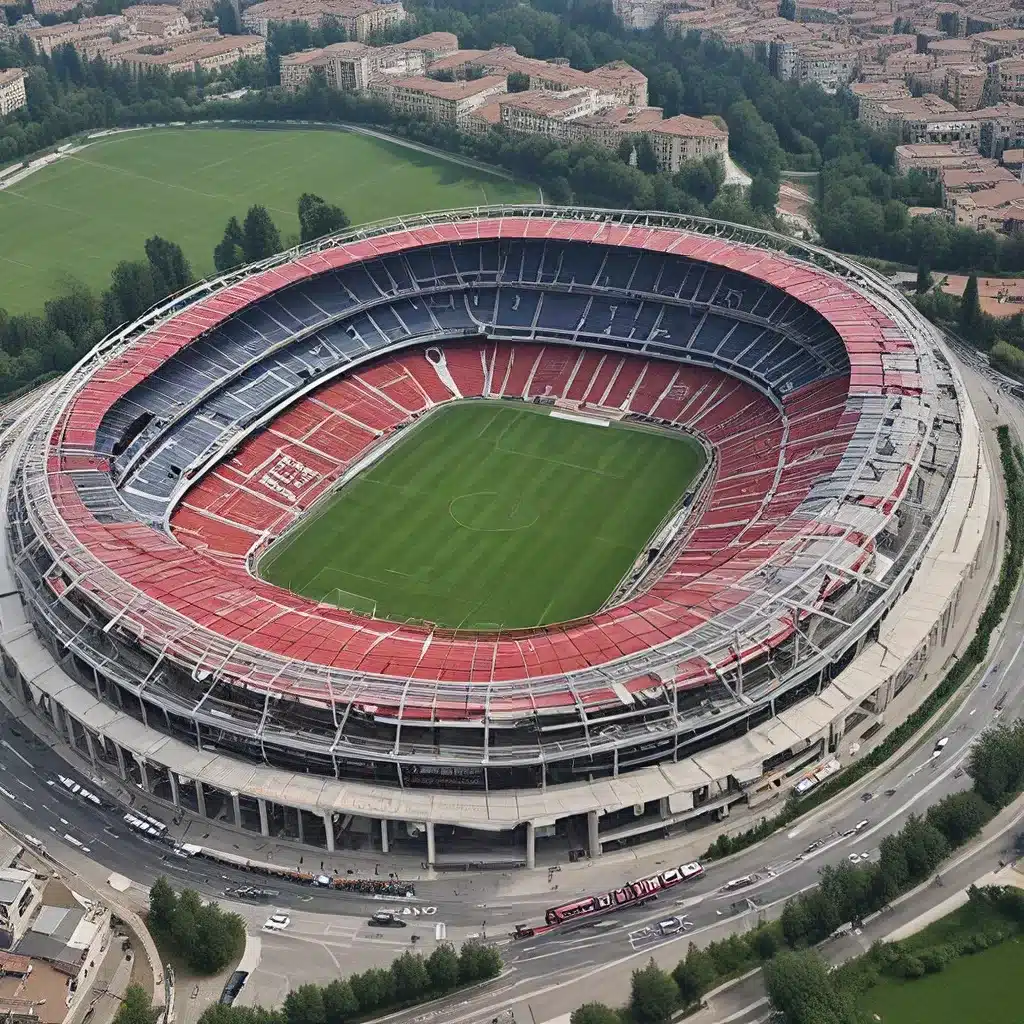
The Storied Past of a Footballing Fortress
The Giuseppe Meazza Stadium, more commonly known as San Siro, stands as an iconic symbol of football’s rich history and passionate following in Milan, Italy. Built in 1925, this legendary stadium has a captivating past that has enthralled fans and enthusiasts alike.
Initially, the stadium was intended to be the new home for both of Milan’s storied clubs – AC Milan and Inter Milan – replacing their former grounds. The stadium was named after Giuseppe Meazza, an Italian football legend who represented both clubs with distinction during his illustrious career.
From its early days, San Siro became synonymous with football excellence and unwavering fan devotion, establishing itself as a cauldron of emotions and an iconic landmark in the city. The stadium’s architecture embodies both elegance and grandeur, designed by architect Ulisse Stacchini. The structure initially had a capacity of 35,000 spectators, but over the years has undergone several renovations and expansions, resulting in its current capacity of approximately 75,000 seats.
One of the distinctive characteristics of San Siro lies in its unique double-tiered stands that envelop the pitch, ensuring an intimate atmosphere where fans can truly immerse themselves in the game. The impressive structure showcases the perfect blend of functionality, aesthetics, and acoustic engineering, creating an unforgettable experience for all those within its walls.
Iconic Moments and Footballing Legends
San Siro has witnessed a plethora of unforgettable footballing moments that have solidified its place in sporting history. The stadium has hosted numerous UEFA Champions League finals, including the legendary “Battle of Champions” in 1963, where AC Milan triumphed over Benfica.
It has also been the stage for iconic matches between AC Milan and Inter Milan, popularly known as the Derby della Madonnina, which showcases the fierce rivalry between the two clubs. These derby matches have captivated fans and enthusiasts alike, with the electric atmosphere and passionate chanting creating an unparalleled spectacle.
Moreover, San Siro has played host to international tournaments, such as the FIFA World Cup in 1934 and 1990, as well as the UEFA European Championship in 1980. These global events brought together footballing giants, captivating millions of fans around the world and further cementing San Siro’s reputation as a premier destination for the sport.
The stadium has been graced by the presence of some of the greatest players in the history of the game. Franco Baresi, Paolo Maldini, Ronaldo, and Zlatan Ibrahimović are just a few of the legendary figures who have etched their names in golden letters on the stands, forever leaving an indelible mark in the memories of the devoted fans.
Architectural Brilliance and Passionate Supporters
San Siro’s legacy extends beyond its physical presence; it has become an emblem of Milan’s cultural identity and a shrine for football enthusiasts worldwide. The twin towers that are part of the stadium’s façade have become iconic symbols of Milan’s skyline, adding to the architectural brilliance of the structure.
The stadium’s acoustic engineering and intimate design have played a crucial role in creating an atmosphere that is unmatched in the world of football. The Curva Nord and Curva Sud stands, known for their deafening noise and reverberating sound waves, have become legendary in their own right, instilling fear and excitement in visiting teams.
The passionate support of the tifosi (fans) of AC Milan and Inter Milan is perhaps the most compelling feature of San Siro. Their unwavering dedication, chants, and songs have become an integral part of the stadium’s identity, making it a true cauldron of emotions and a testament to the power of football in unifying communities.
The Derby della Madonnina is not just a football match; it is an expression of culture and an emotion that transcends the boundaries of the sport. This rivalry, which divides the city, ultimately brings it together, showcasing the strength of sport in shaping self-identity and community.
The Future of a Footballing Icon
There is no doubt that San Siro holds immense historical value, but the stadium has been a point of debate over its future. Proposals have been made to either renovate the old structure or construct a completely new stadium, leading to heated exchanges between fans and preservationists alike, whose desire is to maintain the stadium’s legacy.
The row over San Siro’s future underlines its importance as much more than a footballing stronghold, but also as a cultural icon. Old Stadium Journey, a website dedicated to exploring the history and significance of iconic sports venues, has highlighted the importance of preserving the stadium’s legacy and the unique atmosphere it has fostered over the decades.
Regardless of the outcome, one thing is certain: the memories, sentiments, and history inscribed on the walls of San Siro cannot be erased. It will forever remain a Mecca of football, a holy ground for all football fans, where the past, present, and future of Italian football are found, where legends of the game live, and where the fans’ passions resound through eternity.
Though discussions continue on its future, there is no doubt that San Siro will never stop being a football holy land in Italy, a sacred place with the rhythm of the hearts of many football-loving people.

